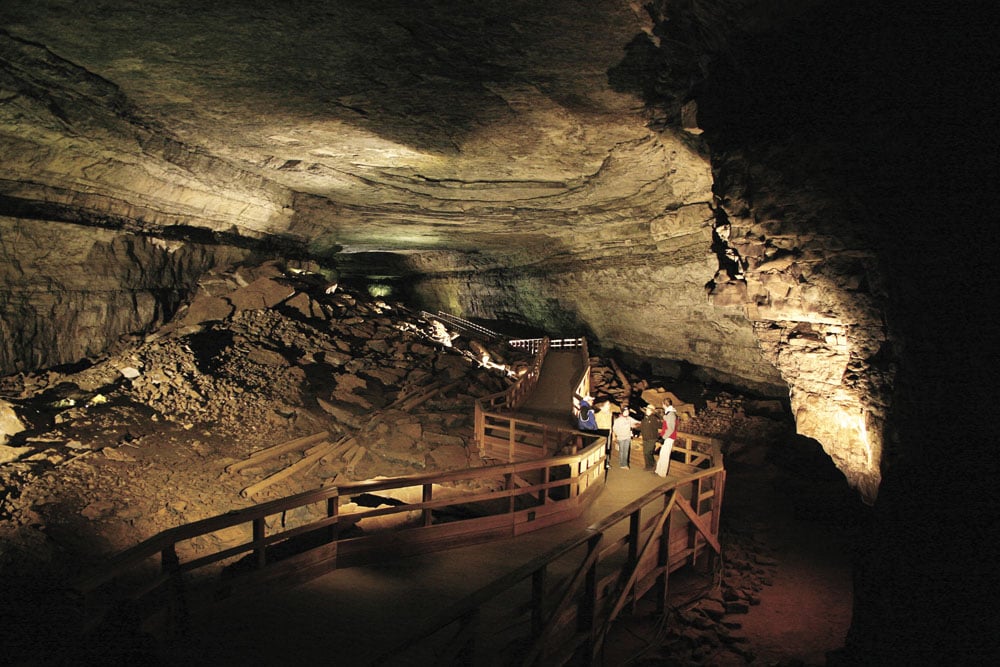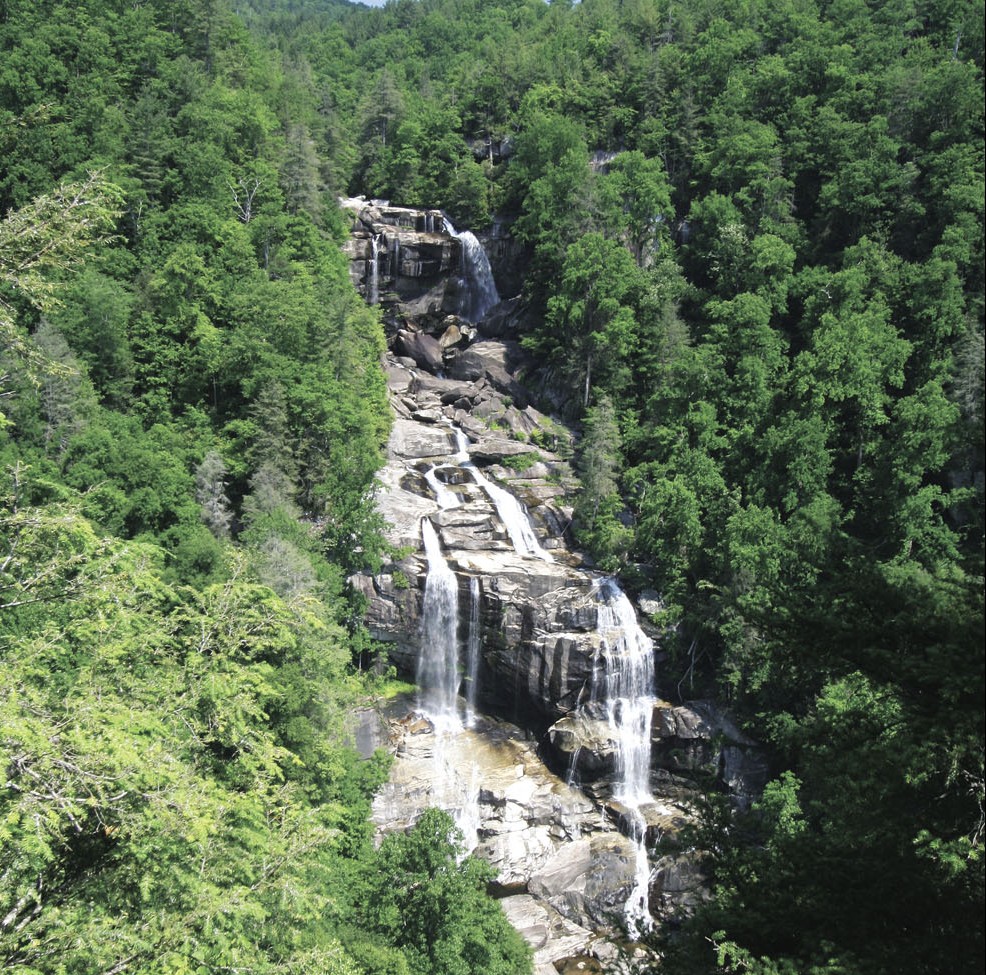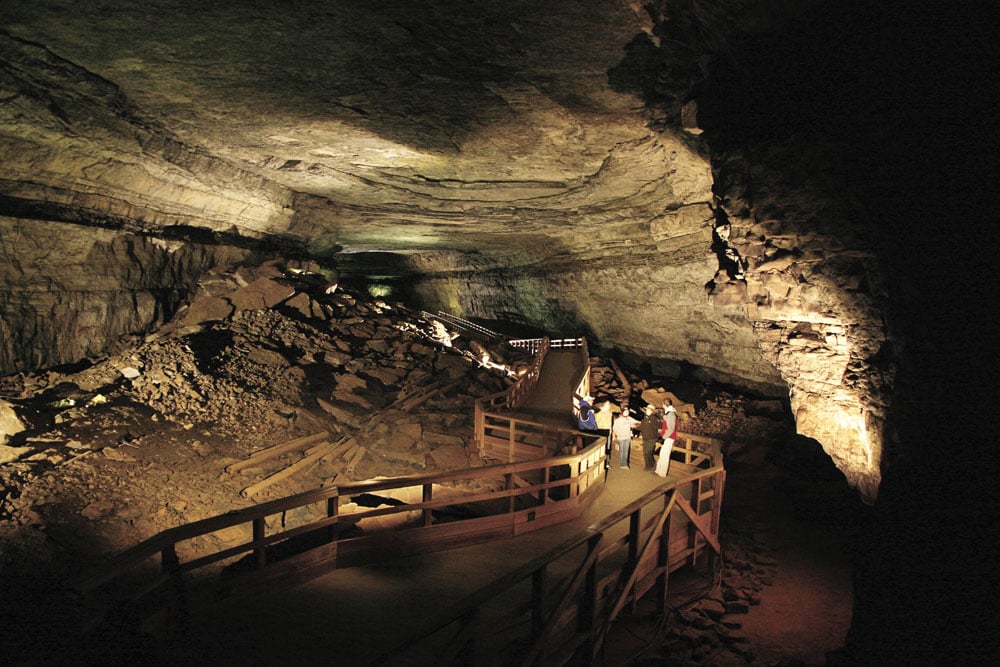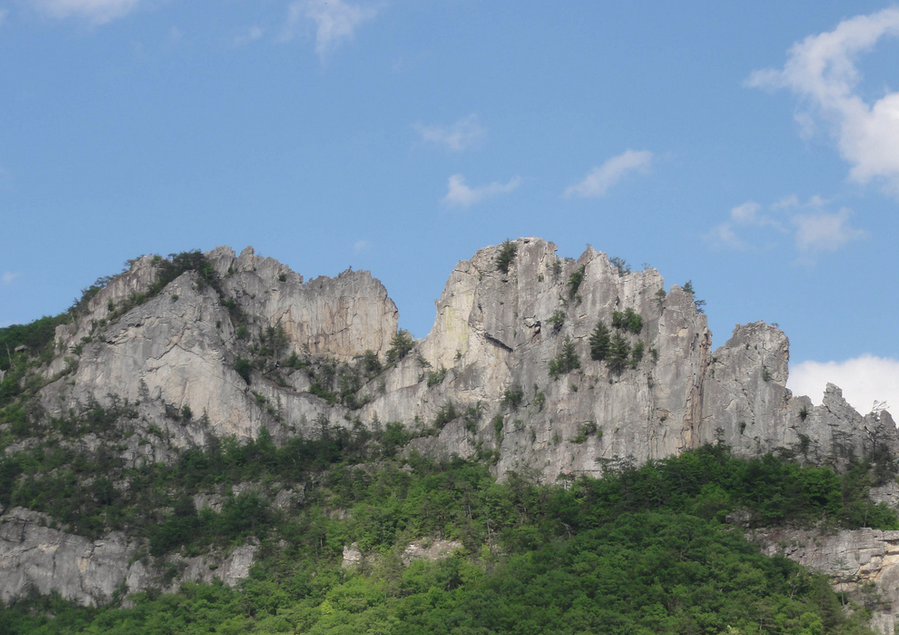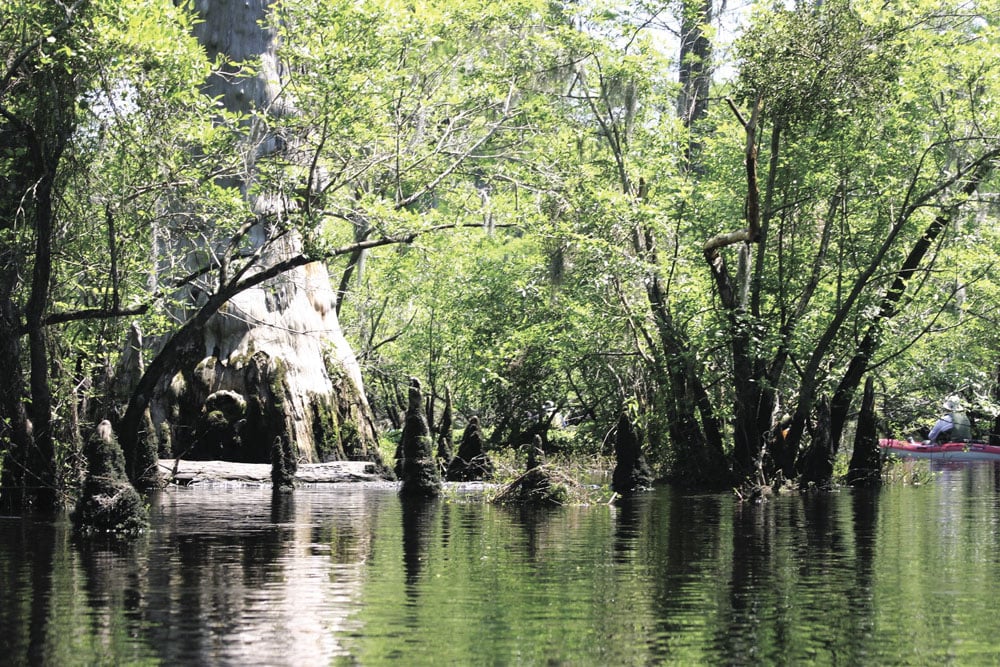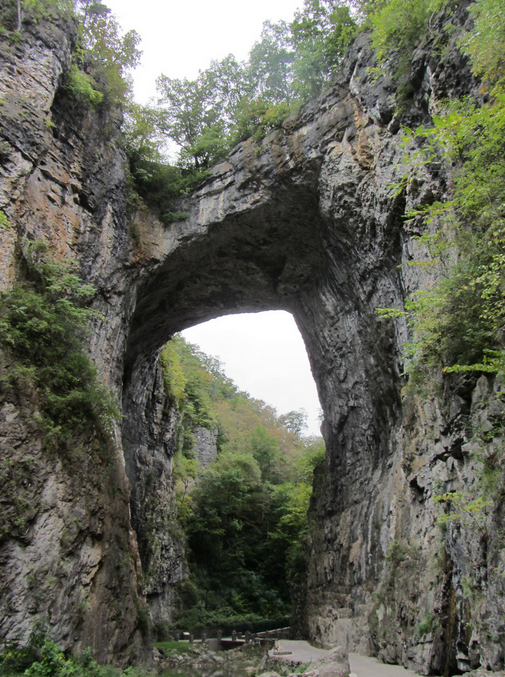You may not have the opportunity to see all of the Seven Natural Wonders of the World for yourself. A trip to see the Aurora Borealis with your own eyes may be out of your price range, and visiting Zimbabwe’s Victoria Falls in person might take longer than your one-week allotted vacation. Luckily, the South has its own suite of natural wonders—locations and phenomenon that will beguile even the most experienced adventure traveler. Some of the places that have made our list have been popular tourist destinations for more than a century, while others have only recently been discovered. They all are awe-inspiring in their own way.
1. Whitewater Falls and the Blue Ridge Escarpment North Carolina
There are waterfalls, and then there is Whitewater Falls, the tallest waterfall east of the Rocky Mountains. You’ll hear that label applied to a number of impressive waterfalls in our region, but measuring 411 feet from top to bottom, Whitewater Falls is the one and true king of falling water in this half of the country. Even better? Just downstream, the Whitewater River drops again in another dramatic plunge that measures 400 feet. Both Upper and Lower Whitewater Falls drop along a topographical phenomenon called the Blue Ridge Escarpment—a drastic and sudden 3,000-foot shift in elevation from flat piedmont to steep mountains that forms an abrupt “blue wall.”
The Escarpment is blessed with more dramatic waterfalls than anywhere else in the East. That’s because the severe uplands also act as a rain maker: only the Pacific Northwest has more rainfall than the Escarpment. As a result, the region has as many rare species as Great Smoky Mountains National Park, and it is the center of the world’s salamander population. With ferns, mosses, fungi, wildflowers, and spray cliffs, the Escarpment is a veritable rain forest, and Upper and Lower Whitewater Falls are the tangible manifestations of this dramatic ecosystem.
See It For Yourself
Whitewater Falls Recreation Area has a paved trail to overlooks of Upper Whitewater Falls. Follow the Foothills Trail for a short hike to see Lower Whitewater Falls in South Carolina. Better yet, hike the entire 80-mile Foothills Trail, which traverses the most severe Escarpment section.
2. Mammoth Cave National Park, Kentucky
Mammoth is the world’s longest known cave system with 367 miles of explored underground rooms and passages. And there’s still plenty more to explore, with miles of “new” cave discovered every year.
“We have a dedicated group of volunteers whose primary job is to explore and map the system,” says Vickie Carson, information officer for Mammoth Cave National Park, explaining that the cave runs beneath four above-ground ridges. “Our explorers drop into remote valleys and find new passages that eventually connect with the main system.”
Some cavers estimate there are at least 600 miles of undiscovered cave still awaiting explorers underground. The terrain in Eastern Kentucky is perfect for caves. The soft limestone rock beneath the surface is tipped slightly toward the Green River, and underground streams and rainwater cut away at the limestone over years, slowly creating the passages we now know as Mammoth Cave. And Mammoth contains everything you’d want in a cave: claustrophobic passages leading to spacious cathedrals, underground rivers with blind fish, stalagmites, and stalagtites.
See It For Yourself
For the general public, the only way into the cave is through a tour guided by the National Park Service. Check out the Wild Cave Tour for the most in-depth experience. You’ll get six hours underground, crawl through nine-inch-wide tunnels, see underground waterfalls, and drop 300 feet below the surface as you travel through 5.5 miles of cave.
Photo by Dion Hinchcliffe
3. Seneca Rocks, West Virginia
The Southern Appalachians may not be as rocky as their counterparts, the Rocky Mountains, but that doesn’t mean we have a shortage of cliffs and stone crags. From Rock City to Old Rag to the Potomac Gorge, we’ve got our share of stone. But the most impressive and unusual outcroppings in our region may just be Seneca Rocks in West Virginia. Seneca consists of a razorback ridge of sheer, vertical fins rising 900 feet from Seneca Creek. The rock is divided into two segments, North Peak and South Peak, divided by a notch. You can reach the top of North Peak via a steep, but accessible hike, but South Peak has the distinction of being the only peak east of the Mississippi that can only be summitted by technical rock climbing.
Seneca Rocks loom high above the valley floor, acting as a focal point for the Spruce Knob-Seneca Rocks National Recreation Area.
“There are other rock formations like this on the same ridge,” says Arthur Kearns, owner of Seneca Rocks Climbing School. “Nelson Rocks and Judy Rocks are similar, but Seneca is the highest concentration of this sort of cliff around. It’s a big uplift of sheer rock, and the quality of rock can’t be matched, which is why the climbing is so good.”
It’s unknown who first scaled the rocks, though evidence of Native American villages has been found in the valley below the formation, so it’s likely that Seneca has been climbed for centuries. One of the first recorded ascents in the 1930s revealed an inscription at the top of the peak, that read “D.B. September 16, 1908.” Climbers started scaling the rocks for sport in the 40s and the U.S. Army used the area to train soldiers for the Italian campaign during World War II. Today, there are almost 400 mapped routes, ranging from 5.0 to 5.12. Seneca is known in the climbing world for its exposure. The climbing on these cliffs is very steep, with impeccable views at all grades. You can climb Seneca as a beginner and have 180 feet of air under your heels on a 5.2 route.
See It For Yourself
The best way to experience the wonder of Seneca Rocks is to climb them. Kearns recommends Old Man’s, the most climbed route at Seneca. It’s a 5.3 that will take you to the summit in five pitches, and represents the easiest path to the South Peak.
If you’re not up for sending the rocks, you’ll have to settle for hiking to North Peak via the popular Seneca Rocks Trail, which zigzags up the mountain for 1.5 miles starting at the Seneca Rocks Discovery Center.
4. BLK 69, North Carolina
Thanks to the pervasive logging in the Southeast, most of our ancient trees were axed over a century ago. Patches of old growth still exist in the Southern Appalachians, with stands of trees typically dating no more than 400 years old. Patches of old growth bald cypress in the swamps of our piedmont, on the other hand, are often twice as old. The Okefenokee has 1,000-year-old bald cypress trees, while trees inside the Congaree National Park in South Carolina have been dated to 1,500 years ago. But if you want to find the oldest trees in the South, you’ve got to paddle the Black River near Wilmington, N.C. There, within the pockets of swamp along the Black, you’ll find stands of 1,700-year-old bald cypress, including BLK 69, the oldest dated tree east of the Rocky Mountains. After taking a core sample of the gnarled cypress, scientists estimate BLK 69 took root sometime around 364 A.D.
“It’s hard to say why these bald cypress escaped logging,” says Hervey McIver, Onslow Bight project manager for the Nature Conservancy, which manages a 3,000-acre preserve on the Black River. “It could be because loggers like solid trees and so many bald cypress are hollow, we don’t know. But the bald cypress has a knack for surviving. These trees can lose a limb and produce another without much of a problem. The tree just hangs in there.”
The Nature Conservancy’s Black River preserve has roughly 1,000 acres of the ancient trees, and more exist outside of the preserve’s boundaries. The gnarled, pretty trees have huge buttresses popping out of the black water. Many of the trees have lost their canopies because of the frequent storms, and some are hollow, but most are still alive and kicking. Finding BLK 69 will be tough. It’s located downstream of the preserve in a swamp called Larkin’s Cove, but it’s unmarked and tough to distinguish from its neighbors.
See It For Yourself
Your only chance of seeing the ancient trees is by paddling the unmarked Black River. The oldest trees can be found inside the Three Sisters Swamp and Larkin’s Cove farther downstream. To get there, you’ll need to paddle a 14-mile stretch between Beatty’s Bridge and the Route 3 Bridge outside of Atkinson. Three Sisters is located between Henry’s Landing road and the Hunt’s Bluff Wildlife ramp.
5. Cranberry Glades Botanical Area, West Virginia
The Cranberry Glades may not be an obvious wonder like Mammoth Cave, but dig into the details of this ecosystem, and you can’t help but be amazed. The federally designated botanical area consists of a cluster of high elevation bogs spanning 750 acres at 3,400 feet in elevation. It is the largest system of bogs in the Mountain State, packed with plants that normally grow in much higher and colder climates. It’s a high elevation swamp with plants that are typically found in the arctic tundra of Canada.
“You see lots of plants you’re not going to find anywhere else in the region,” says Diana Stull, director of the Cranberry Mountain Nature Center. “Basically, you’re looking at an ecosystem that’s left over from the last ice age.”
A ghostly white sphagnum moss covers much of the ground, while short cranberry shrubs dominate other sections of the area. All of the surface vegetation is underscored by 10 feet of decaying plants, or peat, that gives the entire forest a spongy consistency. More than 60 unique plant species can be found in and around the bogs, including snakemouth orchids, skunk cabbage (a big, green leafed plant that stinks), wild cranberries, and carnivorous plants like the purple pitcher and the tiny sundew. Carbon dating puts the peat bogs at 10,000 years old, a holdover from colder times. According to a study by West Virginia’s Department of Natural Resources, there are fewer than 20 of these high elevation cranberry bogs in the world.
See It For Yourself
Visitors aren’t allowed to walk on the spongy surface of the bogs, but the half-mile boardwalk trail will take you through the heart of the ecosystem, and the eight-mile Cowpasture Trail is a natural surface path that forms a loop around the entire botanical area. Picking the cranberries within the botanical area is forbidden, but go early in the morning and you might see black bears foraging the berries and skunk cabbage.
6. Stone Mountain, Georgia
Today, Stone Mountain is etched with the portrait of Robert E. Lee and his Confederate cohorts; there’s also a light show during the summer, a snow park during the winter, and a tram running to the top. But imagine what Stone Mountain would have felt like before it became a tourist destination. Picture this massive granite dome as the Creek Indians saw it: a sheer mountain of rock, rising almost a thousand feet from the piedmont, unlike any other mountain within hundreds of miles. Even with the kitschy tourist trappings, Stone Mountain still looms impressively over its surroundings.
Rising 786 feet from the forest floor, Stone Mountain is one of the most unusual granite peaks in the Southeast. Unlike other rock domes in our region, Stone Mountain is almost completely devoid of a forest canopy. Its summit stands bare, a solid rock monolith. And what you see is just the beginning. According to geologists, the rock mountain extends for nine miles underground.
Stone Mountain’s history is equally fascinating. At least 12 Archaic Indian sites have been found around the mountain. On the summit, the prehistoric Woodland Indians built a rock wall encircling the top of the mountain. Later, Creek Indians called the peak Lone Mountain and used it as a sacred meeting place. Settlers moving west used the mountain as a landmark in late 1700s. Anything west was considered Indian Territory. Creek Indians finally ceded the land to the state of Georgia in 1821. On Thanksgiving night in 1915, a group of Ku Klux Klan members burned a cross on top of the mountain that was visible from downtown Atlanta. Over the next 45 years, Klan members held meetings on the mountain, which became a symbol of the white supremacist group. In 1963, Martin Luther King put an end to that dark era of Stone Mountain by mentioning it in his I Have a Dream speech, saying, “Let freedom ring from Stone Mountain of Georgia.”
See It For Yourself
Forget the tram, climb the 1.3-mile Walk Up trail from the base to the summit and soak in the views of Atlanta from the top. On a clear day, you can even see the string of Appalachian Mountains rising in the distance. You can also hike or run the five-mile loop around the mountain’s base.
Photo by David Wilson
7. Natural Bridge, Virginia
The 20-story limestone arch is 100 feet wide and 200 feet tall, forming a bridge over Cedar Creek, a tributary of the James. The bridge has amazed visitors for centuries. In 1774, Thomas Jefferson bought the natural arch and its surrounding land for 20 shillings from King George III and quickly built a cabin for visitors. In the late 1800s, Natural Bridge was considered one of the natural wonders of the world, on par with Niagara Falls as a must-see site for international tourists.
Like most natural arches, the bridge was formed over millions of years. The waters of Cedar Creek slowly eroding away at the softer layers of limestone beneath the bridge that remains today. The Monacan Indian explanation for the bridge is a bit more exciting, though: Once, while fleeing a rival tribe, the Monacan came to Cedar Creek and prayed for a safe route across the bluffs and torrential whitewater. When they stopped praying, the bridge appeared, spanning the length of the canyon. The Monacans called it the “Bridge of God,” and named the route over the bridge, the “Great Path.” Later, the bridge would become an important trade route for settlers, and eventually, the path for Highway 11.
See It For Yourself
An easy trail leads to the bridge, while a wax museum portrays prominent figures from American history. A light show illuminates the bridge at night. Also, check out the caverns adjacent to the bridge. You can take a self-guided tour that drops 34 stories into the ground and explores massive rooms of stalactites. •
HONORABLE MENTIONS
Fireflies and Flytraps
Synchronous Fireflies
Fireflies are common to every backyard in the South, but the Elkmont area of Great Smoky Mountains National Park has the only species of firefly in the country that blink in perfect synchronicity. In fact, Photinus carolinus in the Smokies are one of only two synchronous firefly species in the entire world. Flashing is part of the firefly’s mating ritual. Males fly around and flash, while females remain stationary and send out response flashes when they see a suitor they like. For the synchronous fireflies, their flashing is a chemical reaction in their bellies just like other species of fireflies, but scientists aren’t exactly sure why, or how, this particular species has managed to become synchronous. The leading theory suggests it’s the result of stiff competition: each fly can sense when its neighbor is going to flash, and simply tries to flash first. The synchronicity occurs in short bursts and ends abruptly in darkness. You’ll get six seconds of total darkness followed by several rapid flashes, then darkness again.
See it for yourself at the Elkmont Campground. The height of synchronous activity in the Smokies is a two-week period in early to mid June. And it’s possible that within the foreseeable future, the Smokies species may be the only species of synchronous firefly left in the world. The other species of synchronous fireflies live in Southeast Asia, but their numbers are dwindling because of timber production and light pollution, which have affected their mating habits.
The Venus Flytrap
This famous carnivorous plant may seem exotic, but the boggy areas in eastern North Carolina and South Carolina are the only places in the world where it is found. The plant finds its home in soil that lacks nutrients, then makes up for the dietary imbalance by eating insects. When unsuspecting insects trigger hairs inside the plant’s “mouth,” the flytrap closes, forming a stomach that secretes digestive juices. See it for yourself in the Green Swamp, a preserve managed by the Nature Conservancy, that houses the flytrap and 13 other species of carnivorous plant.
SOUTHERN SUPERLATIVES
Oldest River in North America
NEW RIVER
350 million years old
Highest Mountain east of the Rockies
MOUNT MITCHELL
6,684 feet
Deepest Gorge east of the Rockies
LINVILLE GORGE
2,000 feet deep
Tallest Waterfall east of the Rockies
WHITEWATER FALLS
411 feet
Longest River
TENNESSEE RIVER
886 miles long according to USGS
Largest Wilderness area in the Southeast
OKEFENOKEE WILDERNESS
354,000 acres
